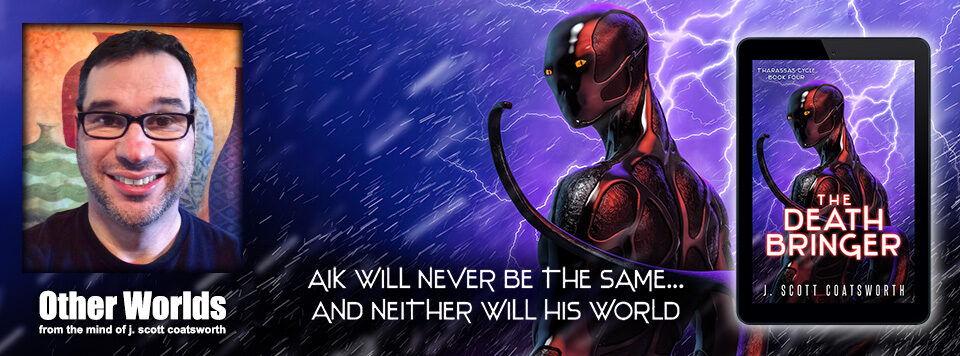
Fiction authors have a lot of things to keep track of in their books- – character descriptions, locations, plot details, and all the other things that go into constructing a world.
It’s a complicated business, building an entire world. But what about when you want to write a series?
When you’re working on a single story, the details are still (fairly) fresh in your mind, and it’s easy enough to flip back and forth through the text (or to use the search function) to find what you need. But writing a series multiplies the details you have to keep track of exponentially.
That’s where the series bible comes in. A series bible is, at heart, a compilation of facts about your world and the stories you set in it. It helps you provide a smooth experience for the reader, avoiding jarring missteps that occur when you forget what one of your secondary characters is called, or that your city is on the shores of the Scayah Sea, and not on a river 300 miles inland.
There are almost as many ways to create and maintain a series bible as there are writers, and the right way for you is whichever one you are most comfortable with.
We asked our friends in Queer Sci Fi what they use to maintain one, and got a variety of suggestions:
- Scrivener offers an immersive writing app that will keep track of the details for you, but might be too complex for some folks.
- Dabble is a similar kind of app that purports to be a little simpler than Scrivener.
- Character Folio has tons of options for tracking all kinds of things about your characters, but is lacking in LGBTQ+ options.
- Campfire is another worldbuilding/series bible app that helps you “overcome disorganization,” according to their website.
- One Note is Microsoft’s note-taking app that also allows you to add other media (pictures, videos, etc). Similarly, some folks use Evernote.
You can also do it much more simply – many folks use Excel or Word to track the details, and many writers prefer the real old-school, utilizing the PPP method – Paper, Pencil, and Post-Its. 🙂
As far as I’m concerned, the “how” is less important than the simple fact of doing it.
I haven’t always created series bibles for my series, or if I did, I often did them later on the back end, which is infinitely harder than keeping track as you go.
Would you rather clean your dishes with every meal, or clean all the dishes from all the meals over a three month period at once?
But I do now. I use a combination of Word for the general details and Excel for things like timelines that I want to be able to work with and sort more easily.
What should you put in your series bible? It will vary a bit by genre. Here’s what I have in my Tharassas bible – a sci fi-fantasy trilogy I am working on:
- General World Description
- Glossary – Animals, Days & Events, People, Peoples (Races, etc). Places, Plants/Food, Streets, Misc.
- Timeline
- Clothing
- Cursing/Colorful Phrases/Idioms
- Religion
- Time Periods/Names
- Population
- Entertainment
- Culture
- Series Outline
- Questions
- Protagonists – Physical, Mental, Emotional, Spiritual, Historical, Motivations, Action Verb(s), Character Type(s) and more
It’s a daunting list, and you may add additional sections and/or discard some of them I listed for my own book. But the good news is that you don’t have to sit down and write all of this out at the get-go. I’ve tried doing it that way, and it slows things down and makes me lose interest in the story.
Just sketch out the most important details at the start. What color is the sky? Where is it set, and what are a few of the most important sense details of the place? Who are your main characters, and what motivates them? And what’s your basic plot? You can fill in the rest as you go.
Your series bible is a WIP, but it’s also a tool, so it should be as easy as possible for you to use.
Each day after you write, transfer any pertinent details over to the series bible, and if they conflict with other things you have already written there, rework your story until they fit.
Pro tip – mark key facts, characters, and place name mentions with a code (for instance, I use the book initials TLR, TR and TMR for the three stories I’ve written in this universe so far) for the book/story in which they appeared. It will make it easier to track them down again later.
No matter how you do it, a series bible will help you keep track of all the nitty gritty details about your stories and your world, and will help you write a more coherent and consistent world and tale.
And don’t be afraid to keep a little mystery in your bible, as my friend Kari Trenten reminded me:
It’s important for it to be contradictory and to contain information that can be interpreted in different ways with enough passion and zeal to create conflict in the universe for different characters who may well have a valid perspective or use it to justify the most outrageous behavior.
Thanks, Kari. Now, when someone points out an inconsistency in one of my books I can say this with a straight face:
I meant to do that.
